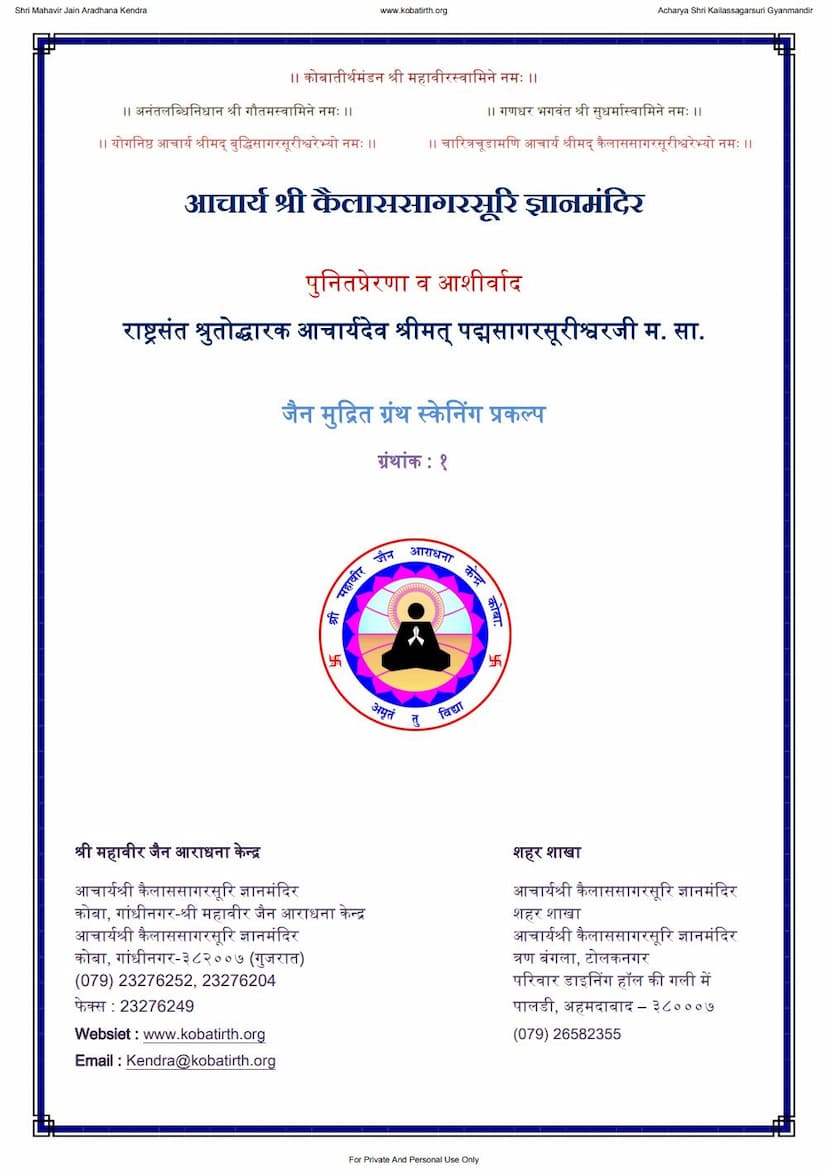Vyavahar Sutram Part 01 Pithika
Added to library: September 2, 2025

Summary
Here's a comprehensive summary of the provided Jain text, focusing on the content of the "Vyavahar Sutram Part 01 Pithika":
This document is the "Pithika" (Introduction/Preface) of the first part of the Vyavahara Sutram, authored by Acharya Muni Chandra Suri. It is published by Omkar Suri Gyanmandir, Surat. The text serves as an introduction to the Vyavahara Sutram, outlining its context, importance, authorship, and the editorial process undertaken for this specific edition.
Key Highlights and Content:
- Salutations and Dedication: The text begins with traditional salutations to revered Jain spiritual figures, including Lord Mahavir, Gautam Swami, Sudharma Swami, and esteemed Acharyas. It is dedicated to various spiritual gurus and respected individuals.
- Editorial and Publishing Details:
- Editor: Acharya Vijay Muni Chandra Suri.
- Assisted by: Muni Divya Ratna Vijay.
- Material compiled by: Agam Prabhakar Muni Shri Punyavijayji.
- Publisher: Acharya Shri Omkar Suri Gyanmandir, Surat.
- First Edition: V.S. 2066 (2010 CE), with a print run of 250 copies.
- Sources: The edition is based on palm-leaf manuscripts and materials prepared by Muni Shri Punyavijayji.
- Nature and Importance of Vyavahara Sutram:
- It is classified as a "Ched granth" (a scripture dealing with disciplinary rules and atonement).
- It discusses subjects like penance (prayschitta) for monks and nuns, making it essential reading only for those with the right qualification, as per the Guru's command.
- The text highlights its immense size, necessitating its publication in six volumes.
- Editorial Process and Scholarly Contributions:
- The editor, Acharya Muni Chandra Suri, emphasizes the extensive research and compilation effort.
- He acknowledges the valuable contributions and verification provided by numerous scholars and Acharyas from various lineages, including Acharya Shri Rajshekhar Suri, Acharya Shri Kulchandra Suri, Acharya Shri Punyaratna Suri, Acharya Shri Yashratna Suri, Pandit Mukti Chandra, and Pandit Muni Chandra.
- The editor expresses gratitude for the support received in collecting ancient manuscripts (palm-leaf, microfilms, photocopies) from various libraries and repositories.
- Authorship and Tradition:
- The text discusses the authorship of the Ched Sutras, attributing them to Acharya Bhadrabahu Swami, a fourteenth-Purvadhar.
- It also addresses the authorship of the Niryukti (commentary on the Sutra), generally attributing it to Bhadrabahu Swami, but also mentions scholarly debates about a later Bhadrabahu or other commentators.
- The complexity of separating Niryukti and Bhashya (another layer of commentary) is noted.
- The commentary (Tika) is attributed to Acharya Malayagiri Suri, a prominent commentator believed to have lived in the 13th-14th century CE and a contemporary of Acharya Hemachandrasuri. His commentary is praised for its clarity, depth, and scholarly rigor. His potential connection to Gujarat is also discussed based on linguistic influences in his Tika.
- The text notes that Acharya Malayagiri Suri also authored a grammar text ("Shabd-anushasan"), which helped resolve issues with his scriptural citations.
- Explanation of "Ched Sutra":
- The term "Ched Sutra" is explained. It is derived from the fact that these texts extensively describe seven out of the ten types of penance (prayschitta): Alochana, Pratikraman, Ubhaya, Vivek, Viyutsarga, Tap, and Ched. While other forms of penance are mentioned, their detailed discussion is less frequent.
- The classification of Ched Sutras is linked to the concept of 'Ched Sutra' in Jain Agamas, signifying rules related to discipline and expiation.
- Analysis of "Vyavahara" (Practice/Conduct):
- The introductory part delves into the meaning and etymology of "Vyavahara." It is derived from the root "hr" meaning to carry or take, with prefixes like "vi" (indicating variety or separation) and "sam" (indicating thoroughness or completeness), implying a process of resolving differences and establishing correct conduct.
- The text breaks down "Vyavahara" into three components:
- Vyavahara: The practice or conduct itself.
- Vyavahari: The person who implements or oversees the conduct (the one who administers penance).
- Vyavahartavya: That which is to be subjected to the conduct or penance.
- These components are explained through analogies, such as a craftsman (potter) and his tools and the product.
- Categories of Vyavahara:
- Agam Vyavahara: Based on the scriptures and the pronouncements of enlightened beings (Kevali, Ganadharas).
- No-Agam Vyavahara: Based on worldly conventions or personal interpretations.
- Laukik Vyavahara: Worldly conduct.
- Lokottar Vyavahara: Transcendent or spiritual conduct.
- Bhava Vyavahara: Inner or mental conduct.
- Dravya Vyavahara: External or material conduct.
- Nirvyakti and Bhashya: The introduction discusses the Niryukti and Bhashya commentaries, their role, and the scholarly efforts to differentiate them and attribute their authorship.
- Penance (Prayschitta) and its Types: A significant portion of the Pithika elaborates on the various types of penance and their related practices, including:
- Pratisevana: Violating vows or rules.
- Sanyojana: Combining or accumulating penances.
- Aropana: Re-application or layering of penances.
- Pratikunchana: Concealing or misrepresenting the nature of an offense.
- The text details specific penances associated with different categories of offenses and individuals (monks, nuns), mentioning various time durations (days, months, years) for expiation.
- Vinaya (Respectful Conduct): The introduction dedicates considerable space to explaining the concept of Vinaya, categorizing it into:
- Karmic Vinaya: Physical actions of respect.
- Vachik Vinaya: Respectful speech.
- Manasik Vinaya: Mental respect.
- Loukopcharik Vinaya: Conventional respectful behavior.
- Detailed examples and classifications are provided for each category.
- Prakarana (Chapters/Sections): The Pithika also lists the subjects covered in the "Pithika" itself, providing a Table of Contents for the introductory material. This includes discussions on Anuyoga-dvaras, Naya, Upakrama, Niskepa, Vyavahara, Vyavahari, Vyavahartavya, Prayschitta, and Vinaya.
- Various Editions and Manuscripts: The text mentions and refers to several other published editions and available manuscripts of the Vyavahara Sutram and its commentaries, highlighting the textual traditions and scholarly engagement with the work.
In essence, this Pithika is a detailed scholarly introduction that lays the groundwork for understanding the Vyavahara Sutram, emphasizing its scriptural status, complex internal structure, and the meticulous research that has gone into producing this edition. It highlights the meticulous attention to detail in Jain scriptural study and commentary tradition.